Laptop Mag Verdict
The Vaio Z Flip's bold display, fast performance and long battery life make it a strong 2-in-1, but the touchpad could be better.
Pros
- +
Long battery life
- +
Strong performance
- +
Gorgeous display
- +
Comfortable stylus
Cons
- -
Stiff keyboard
- -
Inconsistent touchpad
- -
Pricey
Why you can trust Laptop Mag
The Lexus of 2-in-1s, the $1,799 Vaio Z Flip offers a bevy of premium features, including a classy gunmetal-gray aesthetic, a unique mechanism that pushes the screen over the lid and high-end performance that rivals the 13-inch MacBook Pro's. This lightweight, 13-inch convertible throws in a colorful display, comfortable stylus and long battery life for good measure. However, at this price, we would expect a more comfortable keyboard and consistently accurate touchpad.
Design
Though Vaio is an independent company no longer owned by Sony, the Z Flip still has the electronics giant's attractive but subtle aesthetic. The device's gunmetal-gray aluminum lid and deck have a distinctive color and texture that you don't see on most other laptops. The company focuses on using premium materials with lightweight, black carbon-fiber on the bottom and sides.
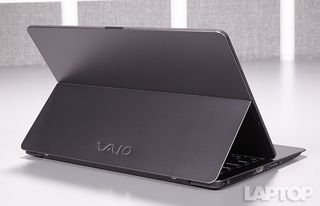
Today, most 2-in-1s are either detachables with slates that separate completely from the keyboard (e.g., the Microsoft Surface) or are bendables with lids that fold back 360 degrees (e.g., the Lenovo Yoga).
However, this Vaio 2-in-1 has a unique method of changing modes, as only its screen flips around, while the device's lid and hinge stay put. After I pulled a release lever that sits just above the middle of the keyboard, the bottom edge of the screen popped out, and I flipped it over so that it covered the back of the lid.
With the screen facing backward, I could use the Vaio Z Flip in presentation mode or could close the lid and use the device as a tablet. Unfortunately, while you can position the screen so that it juts out over the keyboard, it's not rigid in that position, so you can't use the laptop in easel mode. The flipping mechanism has one advantage over bend-back designs, like the one in the Yoga 900, in that you don't need to lift the laptop off of a table before converting to tablet mode. But otherwise, the Z Flip's design offers no real advantages.
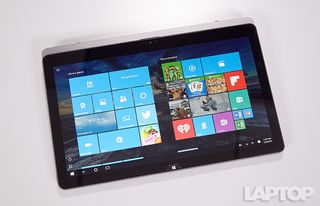
When in tablet mode, the Vaio's display doesn't completely cover the lid, leaving a small, 0.25-inch lip that looks unattractive but is good for gripping the slate. The device also has a lens in the bottom -- something we've never seen before on a laptop -- which serves as a rear-facing camera when you're holding the slate up.
At 2.96 pounds and 8.5 x 12.8 x .66 inches, the Vaio is certainly thin and light enough to carry anywhere. However, Lenovo's Yoga 900 is bit svelter, at only 2.8 pounds, while detachables like the Surface Pro 4 and Spectre x2 are less than 2 pounds. The Microsoft Surface Book is heavier, at 3.34 pounds.
Display and Audio
The Vaio Z Flip's 13.3-inch, 2560 x 1440 display provided rich, detailed images in our tests. When I watched a 1080p trailer for Captain America: Civil War, I could easily make out the stitches in Chris Evans' slate-blue sweater and a reddish-brown mole on Scarlett Johansson's face. Superman's suit in the Batman v Superman: Dawn of Justice trailer had a deep, dark blue tone with a highly visible texture pattern.

According to our colorimeter, the Vaio Z's screen can reproduce 119 percent of the sRGB color gamut, which is far more than the 80.9 percent category average and comfortably ahead of all of the Flip's competitors. However, the Yoga 900, Surface Book, 13-inch MacBook Pro and the Surface Pro 4 all have higher-resolution panels.
The Z Flip's display is reasonably color-accurate, as it notched a Delta-E rating of 1.02 (zero is perfect), which is better than the category average of 4.4 and the Lenovo Yoga 900's mark of 2.8. However, the Surface Pro 4 (0.4) and Surface Book (0.6) were more accurate.
MORE: Best Ultrabooks (Thin-and-Light Windows Laptops)
The screen on the Vaio Z Flip gets really bright, reaching a maximum of 346 nits, well above the ultraportable category average and the Yoga 900's score, but not quite as bright as the Surface Pro 4, Surface Book or MacBook Pro, all of which hit 380 nits or higher. Colors stayed true up to 45 degrees to the left or right, but darkened slightly at wider viewing angles.
Audio
Mounted below the front lip, the Vaio Z Flip's speakers are a mixed bag, producing an interesting separation of sound, but quite a bit of distortion. When I played the disco classic "Car Wash," the vocals and music sounded like they were coming out of different sides of the deck, but high tones like drums were tinny. Listening to a series of guitar-heavy songs, including "Holy Diver," I heard the speakers buzz unpleasantly during the highest-pitched riffs. The sound was loud enough to fill a small living room at maximum volume, but noticeably muffled when I put the device flat on my lap.
Keyboard
The Vaio Z Flip's stiff, shallow keyboard makes for an uncomfortable typing experience, which feels a lot like pressing your fingers into a rock. The keys are well-sized and well-located, but have just 1.1mm of vertical travel, far below the 1.5mm to 2mm we like to see. However, laptops such as the 12-inch MacBook Air manage to provide pleasant, snappy tactile feedback in spite of their short travel by offering some resistance. Unfortunately, the Vaio Z's keys require only 50 grams of force to actuate (55 to 60 g is typical) which means touch typists will find themselves "bottoming out" or hitting the keyboard base with a lot of force.
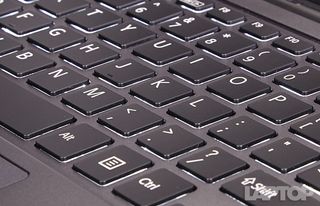
When I performed the 10 Fast Fingers typing test on the Vaio Z Filp, I had a whopping 10 percent error rate and reached a speed of just 82 words per minute, whereas my typical scores are 95 wpm and 1 to 2 percent. Because of the weak feedback, I found myself missing a lot of letters and, worse, my fingers felt a bit sore from bottoming out so much.
Touchpad
The 4.2 x 2.6-inch touchpad is comfortable but suffered from accuracy issues in our testing. The first review unit we received had an extremely jumpy pad; as I moved across the screen, the cursor would sometimes teleport itself several pixels ahead of where I was moving. Vaio then sent us a second model on which the pad wasn't jumpy but was occasionally sticky. It stopped the pointer for a second or two when we were drawing figure eights in Paint or navigating across the desktop.
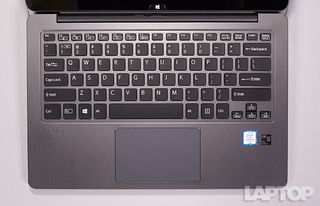
Because both review units we received are pre-production models, we can't tell whether these problems were single-time manufacturing defects, driver issues that could be fixed with a software update or endemic problems any consumer would experience.

Unlike with many touchpads, on both units the cursor was stable when I double-clicked. The Vaio Z responded immediately and consistently to multitouch gestures, such as pinch-to-zoom and three-finger-swipe (to minimize windows). The pad's matte-mica texture also felt pleasant against my finger, offering just enough traction without feeling rough.
Stylus
The Vaio Z Flip's included active stylus was extremely comfortable to hold and accurate to use. With a rollerball-like tip, metal clip and pleasant rubber finger grip, it looks and feels just like a real pen. The glossy screen did feel a bit slippery when we were writing on it; by contrast, the Surface Pro 4 pen provides friction (and customizable tips), which makes it feel more like you're scribbling on paper.
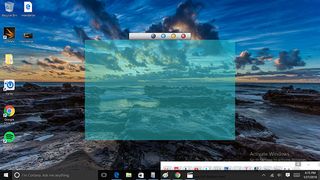
Artists and other creative professionals will appreciate how smoothly you can draw lines and shapes with the pen, an experience I had when using both OneNote and Windows Paint. I particularly enjoyed editing a WordPad document by scribbling words into Windows 10's built-in OCR keyboard. Because of the pen's accurate performance, my on-screen handwriting looked as good as it does on paper, allowing the operating system to convert most of my scribbles into the correct ASCII words.
MORE: Best 2-in-1s (Laptop/Tablet Hybrids)
With support for 1,024 levels of pressure, the stylus created thicker or thinner lines in OneNote, depending on how hard we pushed the pen against the screen. Vaio says that the Z Flip's screen is designed to minimize parallax, the difference between where you place the pen tip and where the lines appear. In our testing, dots appeared right where we drew them.
Heat
The top surface of the Vaio Z Flip stayed relatively cool throughout our tests, but the bottom got a little warm. After we streamed a video for 15 minutes, the bottom surface measured 100 degrees Fahrenheit, the keyboard clocked in at 94 degrees and the touchpad was a chilly 77 degrees. We consider temperatures above 95 degrees to be uncomfortable.
Ports
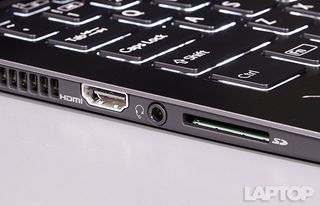
The 0.66-inch thick Vaio Z Flip doesn't have space for a lot of ports, but it packs in a few essential connectors. The right side houses two USB ports, one of which can charge devices when the laptop is asleep, while the left side contains an HDMI port, a 3.5mm audio jack and an SD card reader.
Cameras
Like most laptop webcams, the Vaio Z Flip's front 0.92-megapixel lens shoots mediocre photos. When I took pictures of my face, under both the fluorescent lights of our office and the LED lamps in my living room, the picture was bright but grainy and washed out.

However, the 8-MP rear camera, which strangely sits on the bottom of the laptop, delivered really strong lowlight images. When I took a photo of a dark area in my living room at night, the image was significantly brighter than real life, with only a modest amount of noise.
Performance
While most higher-performance 2-in-1s or laptops use 15-watt versions of Intel's Core i5 or Core i7 processors, the Vaio Z Flip packs a 28-watt Intel 6th Generation Core Series chip that delivers more computing power. Our review configuration of the Vaio offered plenty of pop with its 2.9-GHz Intel 6th Generation Core i5-6267U CPU, Intel Iris Graphics 540 GPU, 8GB of RAM and speedy 256GB PCIe SSD. Even when I had over a dozen tabs open and a 4K video playing in another window, the laptop's performance was buttery smooth. Just don't expect to game on this notebook or do graphics-intensive work.
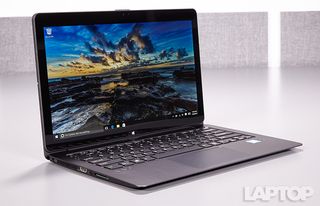
On Geekbench 3, a synthetic benchmark that measures overall performance, the Vaio Z Flip scored a strong 7,235, way ahead of the ultraportable laptop category average (4,774) and noticeably quicker than the Core i7-6500U-powered Lenovo Yoga 900 (6,264), Core m7-6Y75-enabled HP Spectre X2, and Core i5-6300U-powered versions of the Surface Pro 4 (6,811) and Surface Book (6,814). The Apple MacBook Pro, which also uses a 28-watt process -- a Core i5-5257U -- returned a similar mark, of 7,113.
The Z Flip's PCIe SSD took just 13 seconds to complete our Laptop File Transfer test, which involves copying 4.97GB of mixed-media files. That's a rate of 391.5 MBps, more than double the 163.5-MBps category average and much quicker than all of the Flip's competitors, except the MacBook Pro (386 MBps), which was only 5 MBps behind.

Because of the device's high-wattage processor, we weren't surprised to see the Vaio Z Flip do really well on our spreadsheet test, which involves matching 20,000 names with their addresses in OpenOffice Calc. Vaio's laptop finished the task in just 3 minutes and 47 seconds, more than twice as fast as the category average (7:53) and around half a minute faster than the Yoga 900 (4:18), Surface Pro 4 (4:11) and Surface Book (4:17). The MacBook Pro was just a little faster (3:28).
Graphics
The Vaio Z Flip's Iris Graphics 540 GPU is supposed to offer better performance than Intel's mainstream graphics chips, but it still isn't good enough to play serious games. The Vaio scored a really strong mark of 89,876 on 3DMark Ice Storm Unlimited, a synthetic benchmark that measures graphics prowess. That's more than double the category average (40,830) and 50 percent better than the Yoga 900 (60,259) and Surface Pro 4 (60,424).
Despite these high scores, the Z Flip mustered just an unplayable 26.7 frames per second when running Rainbox Six Seige at 1080p resolution with low special effects. That rate rose to an acceptable 42.8 fps at 1366 x 768, but that's well below the display's native, 2K resolution.
Battery Life
Vaio miniaturized the motherboard, a feature the company calls the "Vaio Z Engine," to make room for a large battery and plenty of cooling on this hybrid. As a result, the Z Flip lasted a strong 9 hours and 4 minutes on the Laptop Mag Battery Test, which involves continuous surfing over Wi-Fi at 100 nits of brightness. That time is comfortably ahead of the ultraportable category average (8:21) and the Yoga 900's showing (7:57), and miles ahead of the Surface Pro 4's mark (6:05). All of those machines use standard, 15-watt processors. However, the MacBook Pro, which also uses a 28-watt CPU, lasted a full 12 hours and 4 minutes, and the Surface Book (15-watt CPU) endured for 12:29.
MORE: Laptops with the Longest Battery Life
Software and Warranty
Vaio includes a couple of useful utilities on top of Windows 10, but this device is thankfully light on the bloatware. The Vaio clipping tool allows you to take and annotate screen shots using the stylus. Vaio control center gives you some control of the power settings, the ability to turn the touchpad on or off, and the ability to use your laptop as an access point. Vaio Pencil Board provides a transparent overlay that you can drag around the screen to help highlight areas for drawing.
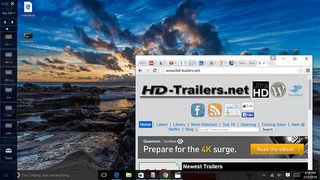
Vaio Shortcut Key puts a toolbar on the left side of the screen with buttons you can tap for quick actions you might normally perform with a keyboard, such as Ctrl + C for copy and paste. You can also toggle the fan mode from silent to performance or adjust pen responsiveness from this tool.
Configurations
The Vaio Z Flip comes in three configurations: The $1,799 base model, which we reviewed here, comes with a 2.9-GHz Core i5-6267U processor, a 256GB SSD, Windows 10 Home and 8GB of RAM. A $1,999 model upgrades to a 3.3-GHz Core i7-6567U CPU and Windows 10 Pro. The $2,399 top config has the Core i7-6567U CPU but jumps to 16GB of RAM and a 512GB SSD.
Vaio Z Flip vs. the Competition
For $1,199, the Lenovo Yoga 900 offers a sharper screen than the Vaio Z Flip, a much better keyboard and a bit lighter chassis. However, the Yoga lacks stylus support, and the 2-in-1 isn't quite as powerful or long-lasting.

For $1,699, or $100 less than the Z Flip, you can get a Surface Book with a Core i5 CPU and a 256GB SSD. That system has a better pen and sharper screen, and lasts 12.5 hours on a charge. If you don't need a 2-in-1, the MacBook Pro 13-inch provides similar performance to the Z Flip but with a much better keyboard, a sharper screen, the best touchpad in the business and 12 hours of battery life.
Bottom Line
The Vaio Z Flip is definitely a head-turning 2-in-1, with its gorgeous, flipping display and sleek design, and the fast performance and long battery life help justify the steep price tag. The pen also works well, even though there's nowhere to put it when it's not in use. However, we found the keyboard uncomfortable, and the issues we had with touchpads on two different review units leave us concerned about the experience users will have.
The Lenovo Yoga 900 isn't as fast as the Flip, but offers more for your money, providing a better keyboard, more reliable touchpad and sharper screen. Overall, though, if you like Vaio Z Flip's compelling design and have the budget, the 2-in-1's strong performance and impressive endurance make it a solid choice.
Vaio Z Flip Specs
| CPU | 2.9-GHz Intel Core i5-6267U |
| Display Size | 13.3 |
| GPS | Yes |
| Graphics Card | Intel Iris Graphics 540 |
| Hard Drive Size | 256GB SSD |
| Hard Drive Type | SSD |
| Native Resolution | 2560 x 1440 |
| Operating System | Windows 10 Home |
| RAM | 8GB |
| RAM Upgradable to | 8GB |
| Size | 8.5 x 12.8 x .66 inches |
| Warranty/Support | one year |
| Weight | 2.96 pounds |
| Wi-Fi Model | Intel Wireless AC 8260 |
